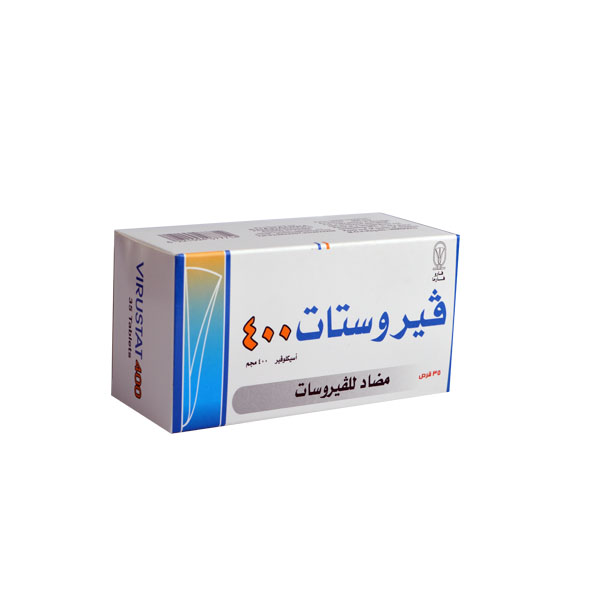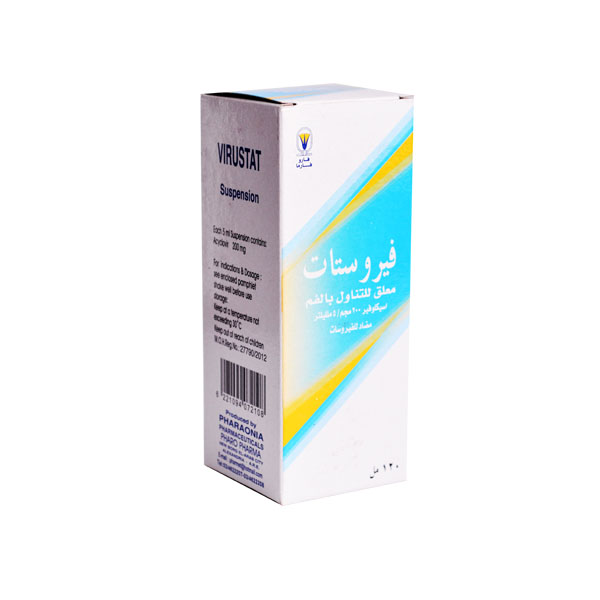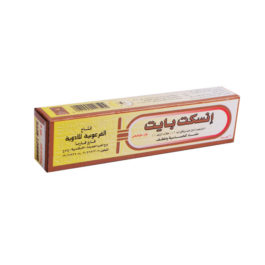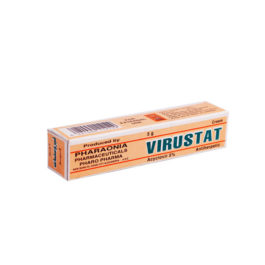Description
THERAPEUTIC INDICATIONS:
Herpes Zoster Infections:
VIRUSTAT is indicated for the acute treatment of herpes zoster (shingles).
Genital Herpes:
VIRUSTAT is indicated for the treatment of initial episodes and management of recurrent episodes of genital herpes.
Chickenpox:
VIRUSTAT is indicated for the treatment of chickenpox (varicella).
POSOLOGY AND METHOD OF ADMINISTRATION:
Dosage In adults:
Treatment of Herpes simplex:-
For treatment of Herpes simplex infections, 200 mg VIRUSTAT should be taken five: times daily at approximately four-hourly intervals omitting the night time dose. Treatment should continue for five days but in severe initial infections it may have to be extended.
In severely immune-compromised patients (e.g. after marrow transplant) or in patients with impaired absorption from the gut the dose can be doubled to 400 mg.
Dosing should begin as early as possible after the start of an infection; for recurrent episodes this should preferably be during the prodromal period or when lesions first appear.
Suppression of Herpes simplex:-
For suppression of Herpes simplex infections in immune-competent patients, 200 mg VIRUSTAT should be taken four times daily at approximately six· hourly intervals.
Many patients may be conveniently managed on a regimen of 400 mg VIRUSTAT taken twice daily at approximately twelve-hourly intervals.
Dosage titration down to 200 mg VIRUSTAT taken three times daily at approximately eight-hourly intervals or even twice daily at approximately twelve-hourly intervals, may prove effective.
Some patients may experience break through infections on total daily doses of 800 mg VIRUSTAT.
Therapy should be interrupted periodically at intervals of six to twelve months in order to observe possible changes in the natural history of the disease.
Prophylaxis of Herpes simplex:-
For prophylaxis of Herpes simplex infections in immune-compromised patients, 200 mg VIRUSTAT should be taken four times daily at approximately six-hourly intervals.
In severely immune-compromised patients (e.g. after marrow transplant) or in patients with impaired absorption from the gut the dose can be doubled to 400 mg.
The duration of prophylactic administration is determined by the duration of the period at risk.
Treatment of Varicella and Herpes zoster:-
For treatment of Varicella and Herpes zoster infections, 800 mg VIRUSTAT should be taken five times daily at approximately four-hourly intervals, omitting the night time dose. Treatment should continue for seven days.
Dosing should begin as early as possible after the start of an infection. Treatment
yields better results if initiated as soon as possible after onset of the rash.
Management of severely immunocompromised patients:-
For management of severely immunocompromised patients, 800 mg VIRUSTAT should be taken four times daily at approximately six-hourly intervals.
The duration of treatment studied in bone marrow transplant patients was 6 months (from 1 to 7 months post-transplant). In patients with advanced HIV disease, study treatment was 12 months, but it is likely that these patients would continue to benefit from a longer duration of treatment.
Dosage in children:-
For treatment of Herpes simplex infections, and for prophylaxis of Herpes simplex infections in the immune-compromised, children aged two years and over should be given adult dosages.
For treatment of Varicella infections, children over the age of six years can be given 800 mg VIRUSTAT four times daily and children between the ages of two and six years can be given 400 mg VIRUSTAT four times daily.
Dosing may be more accurately calculated as 20 mg VIRUSTAT/kg bodyweight (not to exceed 800 mg) four times daily. Treatment should continue for five days.
No specific data are available on the suppression of Herpes simplex infections or the treatment of Herpes zoster infections in immune-competent children.
Limited data suggest that for management of severely immunocompromised children, over two years of age, the adult dose may be given.
Dosage in the elderly:-
In the elderly total acyclovir body clearance declines in parallel with creatinine clearance. Adequate hydration of elderly patients taking high oral doses of VIRUSTAT should be maintained.
Special attention should be given to dose reduction in elderly patients with impaired renal function.
Dosage in renal impairment:-
In the treatment and prophylaxis of Herpes simplex infections in patients with impaired renal function, the recommended oral doses will not lead to accumulation of acyclovir above levels that have been established safe by intravenous infusion. However, for patients with severe renal impairment (creatinine clearance less than 10 ml/minute) an adjustment of dosage to 200 mg twice daily at approximately twelve-hourly intervals is recommended.
In the treatment of Varicella and Herpes zoster infections, and in the management of severely immunocompromised patients it is recommended to adjust the dosage to 800 mg twice daily, at approximately twelve-hourly intervals, for patients with severe renal impairment (creatinine c1earance less than 10 ml/minute) and to 800 mg three times daily at intervals of approximately eight hours. for patients with moderate renal impairment (creatinine clearance in the range 10 to 25 ml/minute).
CONTRA-INDICATIONS
VIRUSTAT Tablets are contraindicated in patients known to be hypersensitive to acyclovir or valacyclovir.
WARNINGS
VIRUSTAT Tablets are intended for oral ingestion only. Renal failure, in some cases resulting in death, has been observed with acyclovir therapy. Thrombotic thrombocytopenic purpura/hemolytic uremic syndrome (TTP/HUS), which has resulted in death, has occurred in immunocompromised patients receiving acyclovir therapy.
Not used for children less than 2 years.
PRECAUTIONS
Dosage adjustment is recommended when administering VIRUSTAT to patients with renal impairment (see DOSAGE AND ADMINISTRATION). Caution should also be exercised when administering VIRUSTAT to patients receiving potentially nephrotoxic agents since this may increase the risk of renal dysfunction and/or the risk of reversible central nervous system symptoms such as those that have been reported in patients treated with intravenous acyclovir. Adequate hydration should be maintained.
INTERACTION WITH OTHER MEDICINAL PRODUCTS AND OTHER FORMS of INTERACTION
No clinically significant interactions have been identified.
Acyclovir is eliminated primarily unchanged in the urine via active renal tubular secretion. Any drugs administered concurrently that compete with this mechanism may increase acyclovir plasma concentrations.. Probenecid and cimetidine increase the AUC of acyclovir by this mechanism, and reduce acyclovir renal clearance. Similarly increases in plasma AUCs of acyclovir and of the metabolite of mycophenolate mofetil, an immunosuppressant agent used in transplant patients have been shown when the drugs are coadministered. However no dosage adjustment is necessary because of the wide therapeutic index of acyclovir
USE DURING PREGNANCY AND LACTATION
Pregnancy
A post marketing acyclovir pregnancy registry has documented pregnancy outcomes in women exposed to any formulation of acyclovir. The registry finding have not shown an increase in the number of birth defects amongst Acyclovir exposed subjects composed with general population and any birth defects showed no uniquness or consistent pattern to suggest a common cause.
Caution should however be exercised by balancing the potential benefits of treatment against any possible hazard.
Teratogenicity
Systemic administration of acyclovir in internationally accepted standard tests did not produce embryotoxic or teratogenic effects in rabbits, rats or mice. In a non-standard test in rats, foetal abnormalities were observed but only following such high subcutaneous doses that maternal toxicity was produced. The clinical relevance of these findings is uncertain.
Lactation
Following oral administration of 200 mg acyclovir five times a day, acyclovir has been detected in breast milk at concentrations ranging from 0.6 to 4.1 times the corresponding plasma levels. These levels would potentially expose nursing infants to acyclovir dosages of up to 0.3 mg/kg/day. Caution is therefore advised if VIRUSTAT is to be administered to a nursing woman.
EFFECTS ON ABILITY TO DRIVE AND USE MACHINERY
The clinical status of the patient and the adverse event profile of VIRUSTAT should be borne in mind when considering the patient’s ability to drive or operate machinery. There have been no studies to investigate the effect of VIRUSTAT on driving performance or the ability to operate machinery. Further, a detrimental effect on such activities cannot be predicted from the pharmacology of the active substance.
ADVERSE REACTIONS
General: Anaphylaxis, angioedema, fever, headache, pain, peripheral edema.
Nervous: Aggressive behavior, agitation, ataxia, coma, confusion, decreased consciousness, delirium, dizziness, dysarthria, encephalopathy, hallucinations, paresthesia, psychosis, seizure, somnolence, tremors. These symptoms may be marked, particularly in older adults or in patients with renal impairment (see PRECAUTIONS).
Digestive: Diarrhea, gastrointestinal distress, nausea.
Hematologic and Lymphatic: Anemia, leukocytoclastic vasculitis, leukopenia, lymphadenopathy, thrombocytopenia.
Hepatobiliary Tract and Pancreas: Elevated liver function tests, hepatitis, hyperbilirubinemia, jaundice.
Musculoskeletal: Myalgia.
Skin: Alopecia, erythema multiforme, photosensitive rash, pruritus, rash, Stevens-Johnson syndrome, toxic epidermal necrolysis, urticaria.
Special Senses: Visual abnormalities.
Urogenital: Renal failure, renal pain (may be associated with renal failure), elevated blood urea nitrogen, elevated creatinine, hematuria (see WARNINGS).
OVERDOSE
Symptoms & signs:
Acyclovir is only partly absorbed in the gastrointestinal tract. Patients have ingested overdoses of up to 20g acyclovir on a single occasion, usually without toxic effects. Accidental, repeated overdoses of oral acyclovir over several days have been associated with gastrointestinal effects (such as nausea and vomiting) and neurological effects (headache and confusion).
Overdosage of intravenous acyclovir has resulted in elevations of serum creatinine, blood urea nitrogen and subsequent renal failure. Neurological effects including confusion, hallucinations, agitation, seizures and coma have been described in association with intravenous overdosage.
Management:- Patients should be observed closely for signs of toxicity. Haemodialysis significantly enhances the removal of acyclovir from the blood and may, therefore, be considered a management option in the event of symptomatic overdose.
PACKING:
Virustat 200 mg tablets: A box containing 20 tablets in 2 PVC/Aluminium strips, each strip of 10 tablets.
Virustat 400 mg tablets: A box containing 35 tablets in 7 PVC/Aluminium strips, each strip of 5 tablets.
Virustat 800 mg tablets: A box containing 35 tablets in 7 PVC/Aluminium strips, each strip of 5 tablets.
Virustat Oral Suspension: A carton box containing glass bottle of 120 ml with a pamphlet.
STORAGE:
Virustat Tablet: Keep at a temperature not exceeding 30°C, in dry place.
Keep out of reach of children.
Virustat Suspension: Keep at a temperature not exceeding 30°C.
Keep out of reach of children.









Reviews
There are no reviews yet.